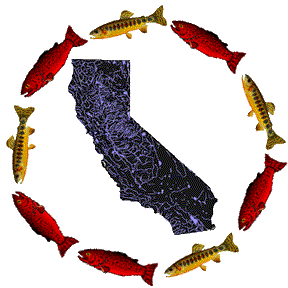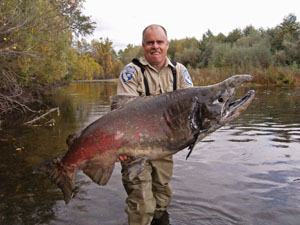CSPA |
| Your 501(c)(3) tax deductible cash donations are desperately needed if the fight for our fisheries is to continue. Read how you can donate! |

 More News
More News
![]()
 DFG Discovers Record Size Chinook Salmon on Survey of Lower Battle Creek
DFG Discovers Record Size Chinook Salmon on Survey of Lower Battle Creek
by Dan Bacher, editor of the FishSnifferNovember 12, 2008 - In a year when the Central Valley fall Chinook salmon population has reached a record low level, one of the largest salmon ever recorded in California was found dead of natural causes in lower Battle Creek near Red Bluff last month by a Department of Fish and Game (DFG) survey crew.
 The fish was discovered a time when fishing and environmental groups are alarmed that an executive order by Governor Arnold Schwarzenegger issued earlier this year could further threaten imperiled populations of Central Valley and Klamath River salmon by cutting the staff needed to conduct surveys of spawning salmon. The order, made during the budget impasse between the Governor and Legislature, terminated temporary help positions from the state�s payroll.
The fish was discovered a time when fishing and environmental groups are alarmed that an executive order by Governor Arnold Schwarzenegger issued earlier this year could further threaten imperiled populations of Central Valley and Klamath River salmon by cutting the staff needed to conduct surveys of spawning salmon. The order, made during the budget impasse between the Governor and Legislature, terminated temporary help positions from the state�s payroll.
According to today's news release from the DFG, the biologists measured the dead fish to estimate what the live weight of it would have been. They used a standard size-to-weight formula to determine the approximate live weight.
Based on measurements of the fish (51 inches long), it could have surpassed the current state angling record for a Chinook salmon of 88 pounds. Biologists estimated the fish to have been between five and six years of age.
"I have counted tens of thousands of salmon during my career and this is the biggest I have ever seen," said Doug Killam, DFG Associate Fisheries Biologist. "When alive, it could have weighed more than the largest Chinook officially recorded in California, an 88-pound fish caught in the Sacramento River."
The DFG biologists found the monster fish during a routine fall-run Chinook salmon survey. Biologists walk through the spawning reach on lower Battle Creek, a tributary of the Sacramento River in Tehama County, on a weekly basis, recording numbers of spawned-out salmon, according to the DFG.
"Most of the salmon they find weigh between 20 and 30 pounds. The size of this salmon literally stopped them in their tracks," according to Killam.
Killam was called and made a special trip to the site with camera in hand to record the size of the fish.
"Because Pacific Chinook salmon die after spawning, surveys counting dead carcasses are commonly used throughout the Central Valley to estimate the number of salmon spawning in each stream," said Killam. "These monitoring surveys provide vital information on the number of salmon returning to specific areas, baseline information for establishing sport and recreational fishing seasons, evaluating hatchery programs, and evaluating habitat restoration and improvement projects."
Killam supervises a crew of employees that work year-round monitoring fish populations throughout the Upper Sacramento River Basin. The monitoring projects use state-of-the-art under water video monitoring techniques and traditional walking surveys to gather information.
The cooperative efforts involve a number of different state resource agencies along with federal entities and non-profit groups and organizations. Four distinct runs of salmon are surveyed: winter, spring, fall and late fall-run Chinook salmon, and steelhead.
"The winter and spring-run Chinook salmon and steelhead are listed under the state and federal endangered species acts, making information on their population size vital in recovery efforts and for state and federal water management activities," Killam emphasized.
"Hopefully this fish was entirely successful in passing on its superior genetic potential," said Killam. "This fish re-defined the word big for me. This is one of the few bright spots this year for one of California's great sport fish, the Chinook salmon."
The crew left the big salmon carcass in the stream with the hope that it will serve as ample food for the next generation of salmon. Through a remarkable food chain that recycles nutrients from the ocean to the stream, these carcasses not only sustain juvenile salmon, but plants, invertebrates and wildlife including otters, bears, raccoons, herons, egrets and vultures.
"These fish go down the river the size of pencils and come back as large adult salmon up to the size of this one," noted Killam. "That would be like a human infant growing up to be the size of a school bus."
Meanwhile, Jeff Shellito of California Trout, Kim Delfino of Defenders of Wildlife, Zeke Grader of the Pacific Coast Federation of Fishermen's Associations and Paul Mason of Sierra Club California are waiting for a response to a letter they sent to Governor Schwarzenegger on October regarding the state hiring freeze's impact upon the ability of the Department of Fish and Game (DFG) to conduct salmon surveys. These surveys are needed to forecast appropriate levels of commercial, sport and tribal harvest of these fish in 2009.
In a letter to Arnold Schwarzenegger and staff dated October 30, they noted that the layoff and hiring freeze required the DFG to leave 31 temporary positions unfilled in the Klamath/Trinity River basin that would normally conduct surveys of spawning salmon in that region.
"This year's unprecedented closure of all commercial salmon fishing underscores our collective responsibility to find state and federal resources to help our remaining salmon runs and the fishing communities that depend on them," the letter stated. "To do otherwise would be penny-wise and pound foolish."
For the first time in history, recreational and commercial salmon fishing in ocean waters off California and Oregon was closed this year. Recreational salmon fishing in Central Valley rivers is also closed, with the exception of a two-month season on the Sacramento River between Knights Landing and Red Bluff. The closures were caused by the unprecedented collapse of Central Valley fall chinook salmon, the driver of the ocean salmon fisheries off the West Coast.
The fall run has plummeted from 800,000 fish in 2002 to less than 60,000 this year. While the Bush and Schwarzenegger administrations blame "ocean conditions" for the collapse, a coalition of recreational anglers, commercial fishermen, Indian Tribes, environmentalists and independent scientists point to record water exports from the California Delta in recent years, declining water quality and the absence of badly needed acclimation pens for hatchery salmon in 2005 and 2006 as key factors in the dramatic decline.